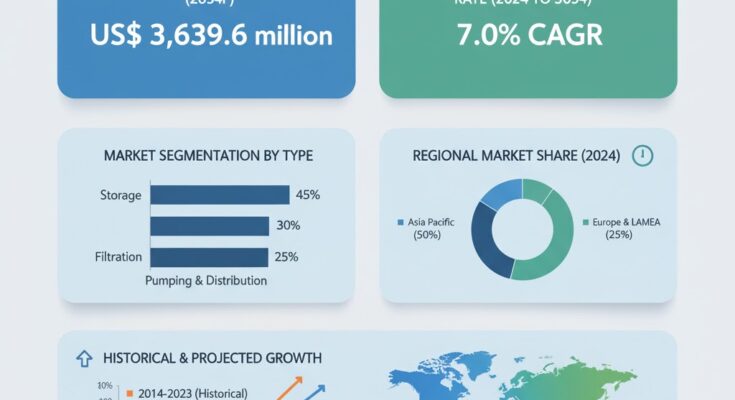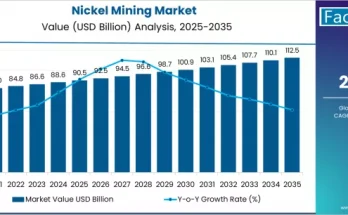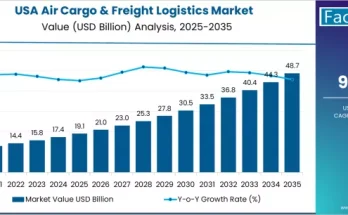The global rainwater harvesting system market is poised for remarkable growth as climate resilience and sustainable water management gain global momentum. According to a recent report by Fact.MR, the market is projected to rise from US$ 1,850 million in 2024 to US$ 3,639.6 million by 2034, expanding at a robust CAGR of 7.0% during the forecast period.
As water scarcity intensifies and governments worldwide promote conservation initiatives, rainwater harvesting systems are becoming an essential solution for residential, commercial, industrial, and agricultural applications.
Strategic Market Drivers
- Rising Water Scarcity and Regulatory Push
Growing freshwater shortages, combined with stringent environmental regulations, are fueling adoption across regions. Governments are increasingly mandating rainwater harvesting structures in new building projects, particularly in urban areas facing severe groundwater depletion. In India, Singapore, and Australia, public policies and incentives are significantly boosting installation rates.
- Sustainable Urban Development and Smart Infrastructure
Rapid urbanization and climate-smart construction are key growth accelerators. Green building standards such as LEED and BREEAM increasingly recognize rainwater harvesting systems for their role in reducing municipal water demand and promoting sustainability. Integration with IoT-enabled monitoring and filtration systems is further enhancing efficiency and performance.
- Agricultural and Industrial Water Efficiency
Rainwater harvesting plays a crucial role in irrigation, livestock farming, and industrial processes. Industries such as textiles, power generation, and food processing are deploying large-scale systems to reduce operational costs and dependence on freshwater sources, aligning with corporate sustainability goals.
Regional Growth Highlights
Asia Pacific: Policy-Driven Adoption
Asia Pacific leads the market, driven by high water stress levels and proactive government initiatives. Countries such as India, China, and Japan are investing in large-scale rainwater collection and storage projects. Rapid urban development and rising public awareness continue to strengthen the region’s dominance.
North America: Technological Advancements
In the United States and Canada, growing demand for eco-efficient water management systems and green building certifications is driving adoption. Advanced filtration, monitoring, and automated control technologies are key differentiators in the North American market.
Europe: Sustainability at the Core
European nations such as Germany, the United Kingdom, and France are at the forefront of implementing rainwater harvesting in both residential and industrial settings. Strict environmental regulations and strong public support for circular economy principles are promoting market expansion.
Emerging Markets: Infrastructure and Awareness Growth
Regions such as Latin America, the Middle East, and Africa are experiencing a surge in demand due to expanding infrastructure, agricultural modernization, and growing climate awareness. Government programs aimed at promoting decentralized water systems are creating new growth opportunities.
Market Segmentation Insights
By System Type
- Roof-Based Systems: Widely used in residential and commercial buildings for domestic water supply and landscaping.
- Surface Runoff Systems: Deployed in industrial and large-scale agricultural settings to collect and store rainwater efficiently.
By End Use
- Residential: Increasing household installations for gardening, toilet flushing, and washing purposes.
- Commercial & Institutional: Schools, offices, and public buildings adopting rainwater systems for sustainability compliance.
- Industrial: Used for process water, equipment cooling, and groundwater recharge.
- Agricultural: Supporting irrigation, livestock, and soil conservation efforts.
Challenges and Market Considerations
Despite its potential, the market faces challenges such as:
- High Initial Installation Costs: Large-scale systems require significant upfront investments.
- Maintenance and Water Quality Concerns: Regular upkeep and filtration are essential for ensuring safe water usage.
- Limited Awareness in Developing Regions: Inadequate knowledge and policy enforcement can restrain adoption.
- Climatic Variability: Regions with low rainfall face challenges in system feasibility and return on investment.
Competitive Landscape
The global rainwater harvesting system market is moderately fragmented, with companies focusing on technological innovation, product integration, and regional expansion.
Key Companies Profiled:
- Kingspan Group PLC
- Graf Group
- WISY AG
- Innovative Water Solutions LLC
- Stormsaver Ltd
- Ecozi Ltd
- Molloy Precast Products Ltd.
- Aquaco Water Recycling Limited
- Watts Water Technologies, Inc.
- D&D Ecotech Services
- KRG India
- N.S. & Associates
- Osmosis India
- Water Field Technologies Pvt. Ltd.
- Water Harvesters
Recent Developments
- July 2023: A team of environmentalists and water treatment experts submitted a memorandum to the Airports Authority of India, proposing the construction of a rainwater harvesting system at Calicut International Airport, India.
- March 2021: Watts Water Technologies introduced an advanced water filtration system in Vietnam’s Lam Dong province to enhance local access to clean water.
Future Outlook: Toward Smart and Resilient Water Management
The coming decade will mark a shift toward intelligent, data-driven, and sustainable water management systems. Integration of AI-based monitoring, cloud data analytics, and automated filtration controls will redefine efficiency standards in rainwater harvesting.
With global emphasis on sustainability and water security, the rainwater harvesting system market is poised to become a cornerstone of climate-resilient infrastructure. Companies prioritizing innovation, cost optimization, and regulatory collaboration will lead the transition toward a water-secure, sustainable future.



